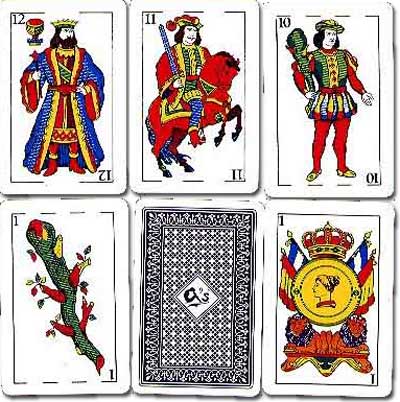Playing Cards in Honduras
Honduras shares a long tradition with Spain in the field of playing cards.
Playing Cards in HONDURAS
COLUMBUS landed in Honduras in 1502, the Spaniards completing the conquest of the country in 1522. Thus Honduras shares a long tradition with Spain in the field of playing cards. The Spaniards were fond of gambling and brought their dice, cards and recreational games with them. In 1583 one Alonso Martínez de Orteguilla was authorised to administer the manufacture and sale of playing cards in New Mexico (which included Mexico, Nicaragua, Guatemala and Honduras). Any local production was effectively suppressed and cards supplied from Spain or Mexico.

Above: throughout the 16th - 18th centuries packs were imported from Spain or Mexico, following Spanish taste and traditions of the day.
In 1821 the states of Guatemala, Costa Rica, Honduras, El Salvador and Nicaragua achieved independence from Spanish rule and formed the Central American Federation until 1838, when the independent Republic of Honduras was established. There has been some local production, following Spanish designs, but most playing cards are imported into Honduras.

Left: pack made in Honduras based upon the Spanish Catalan pattern, and with a slightly modified ace of coins so that the Honduras flag is shown draped behind the Spanish one.

By Simon Wintle
Member since February 01, 1996
I am the founder of The World of Playing Cards (est. 1996), a website dedicated to the history, artistry and cultural significance of playing cards and tarot. Over the years I have researched various areas of the subject, acquired and traded collections and contributed as a committee member of the IPCS and graphics editor of The Playing-Card journal. Having lived in Chile, England, Wales, and now Spain, these experiences have shaped my work and passion for playing cards. Amongst my achievements is producing a limited-edition replica of a 17th-century English pack using woodblocks and stencils—a labour of love. Today, the World of Playing Cards is a global collaborative project, with my son Adam serving as the technical driving force behind its development. His innovative efforts have helped shape the site into the thriving hub it is today. You are warmly invited to become a contributor and share your enthusiasm.
Related Articles

Braulio Fournier
Baraja Nº 1 produced by Braulio Fournier, Burgos, c.1868.

Spanish pattern by Eugène Boisse
Spanish pattern published by Eugène Boisse, Bordeaux.

QAIPES – cartas españolas
Spanish-suited cards made in China inscribed “QAIPES” and “BAIPES”!

Naipes Kukuxumusu
A 52-card Spanish-suited advertising pack for a clothing company in Pamplona.

Spanish-suited deck by J.Y. Humphreys
A rare Spanish-suited deck published by J.Y. Humphreys, Philadelphia, c.1816.

P. Buscaglia: Spanish-suited cards
Spanish-suited cards published by P. Buscaglia, Mele & Genova.

XV Century Spanish-suited playing cards
XV Century Spanish-suited playing cards with moorish influences

Bertschinger y Codina
Fantasy Spanish-suited playing cards by Bertschinger y Codina (Barcelona), c.1850.

Alphonse Arnoult Spanish-suited pack
Luxurious Spanish-suited pack made by Alphonse Arnoult, Paris, France, c.1850.

Clemente Roxas double-ended Spanish pack
Double-ended Spanish-suited playing cards published by Clemente de Roxas in Madrid, 1814.

Antoine de Logiriera
Archaic Spanish-suited playing cards published in Toulouse by Antoine de Logiriera (1495-1518).

J. Deluy c.1490s
Archaic Spanish-suited cards produced by J. Deluy c.1490s.

Wüst Spanish pattern
Wüst Spanish pattern c.1910 advertising Cuban ‘Tropical’ beer.

Hermanos Solesio
“Money Bag” pattern by Hermanos Solesi, late 18th c.

Kem ‘Spanish’ playing cards
Kem ‘Spanish’ playing cards appear to depict Spanish conquistadors © 1994.

Cádiz Pattern playing cards
A popular Spanish playing card pattern widely exported to Spanish-influenced markets.
Most Popular
Our top articles from the past 28 days

